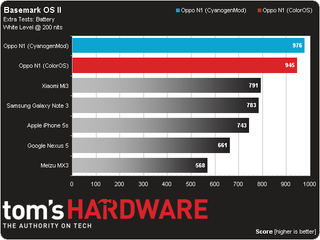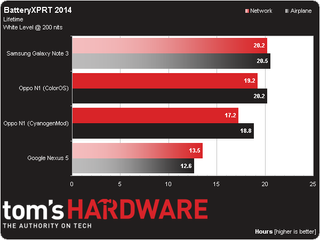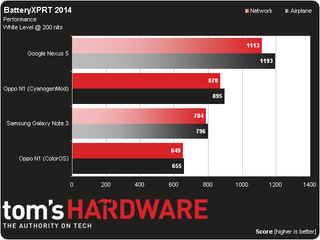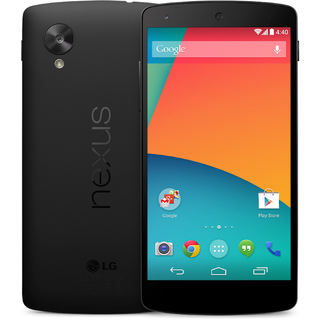Oppo N1 Review: Future-Looking Phablet Or Oversized Flop?
Oppo's N1 sports a unique pivoting camera, a large-format display, and two different operating system options. Are those features enough to make up for an older hardware platform and dicey software optimization in a sea of compelling competition?
Why you can trust Tom's Hardware
Results: Battery Life And Performance
Basemark OS II
Basemark OS II comes with a demanding battery test that almost completely drains the phone from 100% power to calculate a final score that represents its power and longevity.

The N1’s large, non-removable 3610 mAh battery provides excellent run-time and leads the pack by a significant margin. It scores about 30 percent better than the iPhone 5s, which is known for its endurance.
What’s bad for performance is a boon for battery life. The Note 3’s overly aggressive frequency scaling algorithm helps it outlast the higher-clocked Nexus 5. It also lasted about 20 percent longer than it did when running Samsung’s benchmark-gaming version of Android 4.3.
BatteryXPRT 2014
BatteryXPRT 2014 for Android estimates battery life. It’s modeled in part after the MobileXPRT benchmark, which consists of ten real world test scenarios encompassing various photo operations and encryption.
BatteryXPRT 2014 can be run in two different modes: Airplane mode, which estimates battery life for a device with no Internet connectivity, and Network mode, which estimates battery life for a device connected to the Internet via Wi-Fi or cellular data connection.

Both the Note 3 and N1 perform well. Samsung's offering lasts the longest in Network mode (an hour longer than the N1 with ColorOS). When connectivity is turned off, however, the Note 3’s advantage over the N1 drops to about 18 minutes.
Operating system choice impacts the N1’s battery life by a small amount, as ColorOS lasts seven percent longer in Airplane mode and 12 percent longer with Wi-Fi turned on than CyanogenMod.
The N1’s brilliant battery life loses some of its luster when we take performance into consideration, though. While it outlasts the Nexus 5 by four to seven hours, the N1 is also 33 percent slower. Considering the large advantage in battery life, this might not be a bad tradeoff.

Even though the N1 with ColorOS lasts longer than the alternative OS, CyanogenMod performs 37 percent better. In this light, CyanogenMod appears to be the better choice for performance per watt, since it provides a big speed boost for a 12 percent battery life hit.
GFXBench 3.0
GFXBench 3.0 measures battery life and performance stability by logging frame and battery discharge rate as the T-Rex test loops at least 30 times. The results are given in two scores: estimated battery life in minutes and the number of frames rendered on the slowest test run (to gauge if a device is throttling).

Looking at battery run-time in isolation, the N1 makes a lasting impression. With ColorOS installed, the N1 runs for 4.7 hours. That's nine percent better than the 4.3 hours from CyanogenMod.

Once again, taking performance into account affects our perception of the battery life results. The iPhone 5s might only run for 1.9 hours, but it maintains a minimum of 41 frames per second without even a hint of thermal throttling.
If the iPhone 5s is the hare, sprinting towards the finish line, then Oppo's N1 is the tortoise, plodding along at 39 percent of the hare’s pace. However, this tortoise stays in the race nearly 2.5x longer. To gauge who truly wins the race, we need to calculate the “distance” each device travels. In this case, the distance traveled is really the total number of frames rendered and velocity is analogous to frames per second. Thus, the total number of frames rendered is simply FPS times battery life.
The overall winner then is the Note 3 with 312,780 frames rendered before its battery gives out. Behind the Note 3, the finishing order is: iPhone 5s (285,360), Oppo N1 (269,760), Nexus 5 (204,240), Xiaomi Mi3 (159,720), and Meizu MX3 (98,670).
These results illustrate the complexity of battery life discussions. There are numerous variables like battery capacity, screen size/efficiency, CPU speed/efficiency, GPU speed/efficiency, etc. that factor into the equation, making it nearly impossible to guess overall performance by looking at the specs for any single piece of hardware.
Current page: Results: Battery Life And Performance
Prev Page Brightness, Black Level, Contrast Ratio, And Gamma Next Page A Phablet For A Niche MarketStay on the Cutting Edge
Join the experts who read Tom's Hardware for the inside track on enthusiast PC tech news — and have for over 25 years. We'll send breaking news and in-depth reviews of CPUs, GPUs, AI, maker hardware and more straight to your inbox.
-
wavetrex Just a small comment about OLED, even if this might not be the place to write about it.Reply
Probably due to to imperfections in the transistors that control the OLED pixels, there is a very faint but perceptible in deep darkness leakage of energy toward the pixels.
Yes, doesn't compare to the obvious light bleed of any TFT display, but the OLED "off" pixels are not truly off, they have a 0.00something-small level of light which could theoretically be measured by some very sensitive equipment.
The eyes are certainly capable of seeing it... -
InvalidError Putting both flash LEDs on the same side so close to the image sensor seems like a missed opportunity to me: putting one LED close to each hinge with the camera in the middle would provide more even lighting and softer shadows.Reply
With the mostly passable image quality, that would not help the N1 much though. -
Onus Please don't put the letters "p" "h" "a" "b" "l" "e" "t" together in that order and treat it like a word.Reply
-
WyomingKnott @onusReply
First time I read the term I had the image of holding my 10" Asus pad up to my face and talking into it. I suppose it's better than a shoe; cleaner, too. -
shahbaz200 Bad GPU, doesn't works well on this device, poor performance, other than that its good device.Reply -
BlankInsanity please respect my opinion, but I don't see why phones need to go bigger. i the 90s phones used to be huge and this was a problem for mobility and so as the years went by they created smaller form factor phones. Now here we are repeating that mistake. A phone is ment to make a small footprint when hidden on it's user such as a pocket. You don't put your tablet in your pocket, I don't see why'd you make a phone out of it. this is just my opinionReply -
jankeke "please respect my opinion, but I don't see why phones need to go bigger. i the 90s phones used to be huge and this was a problem for mobility and so as the years went by they created smaller form factor phones. Now here we are repeating that mistake. A phone is ment to make a small footprint when hidden on it's user such as a pocket. You don't put your tablet in your pocket, I don't see why'd you make a phone out of it. this is just my opinion "Reply
True but people couldn't watch porn on their phones back then so it made sense to make them as small as possible. Not so now ... ^^ -
Matthew DiGiacomo No offense Tom's Hardware but why are you reviewing this phone now? It's outdated and been on the market for almost 8 months.. No one really cares about it anymore.Reply -
falchard The Camera is a smart solution meaning you won't need 2 cameras. Obviously it will need tilt support to tell it which direction is up.Reply
No removable battery is a shitty solution. Its the issue all phones face after 2 years, their batteries no longer hold a charge. -
BlankInsanity Reply13717317 said:The Camera is a smart solution meaning you won't need 2 cameras. Obviously it will need tilt support to tell it which direction is up.
No removable battery is a shitty solution. Its the issue all phones face after 2 years, their batteries no longer hold a charge.
lol that's a scam the companies do to force you to buy a new one ;)



